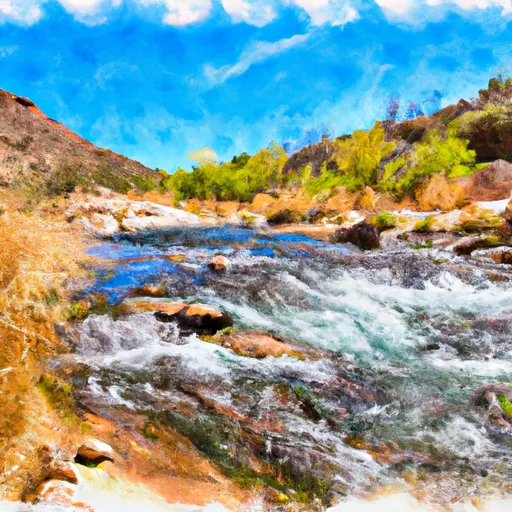Summary
Total streamflow across the
Bill Williams River
was last observed at
37
cfs, and is expected to yield approximately
73
acre-ft of water today; about 137%
of normal.
River levels are high.
Average streamflow for this time of year is
27 cfs,
with recent peaks last observed
on
2022-08-15 when daily discharge volume was observed at
9,976 cfs.
Maximum discharge along the river is currently at the
Bill Williams River Below Alamo Dam
reporting a streamflow rate of 36.6 cfs.
This is also the highest stage along the Bill Williams River, with a gauge stage of
12.08 ft at this location.
This river is monitored from 2 different streamgauging stations along the Bill Williams River, the highest being situated at an altitude of 975 ft, the
Bill Williams River Below Alamo Dam.
River Details
| Last Updated | 2025-12-31 |
| Discharge Volume | 73 ACRE-FT |
| Streamflow |
36.6 cfs
+0.9 cfs (+2.52%) |
| Percent of Normal | 136.57% |
| Maximum |
9,976.4 cfs
2022-08-15 |
| Seasonal Avg | 27 cfs |
River Streamflow Levels
| Streamgauge | Streamflow | Gauge Stage | 24hr Change (%) | % Normal | Minimum (cfs) | Maximum (cfs) | Air Temp | Elevation |
|---|---|---|---|---|---|---|---|---|
|
Bill Williams River Below Alamo Dam
USGS 09426000 |
37 cfs | 12.08 ft | 2.52 | |||||
|
Bill Williams River Near Parker
USGS 09426620 |
16 cfs | 2.36 ft | 7.89 |
Seasonal Discharge Comparison
Maximum Streamflow Discharge
Streamflow Elevation Profile
The Bill Williams River is a 46.3-mile-long (74.5 km) river in west-central Arizona where it, along with its tributary, the Santa Maria River, form the boundary between Mohave County to the north and La Paz County to the south. It is a major drainage westwards into the Colorado River of the Lower Colorado River Valley south of Hoover Dam and Lake Mead, and the drainage basin covers portions of northwest, and west-central Arizona. The equivalent drainage system paralleling the east–west lower reaches of the Bill Williams is the Gila River, which flows east-to-west across central Arizona, joining the Colorado River in the southwest at Yuma. The confluence of the Bill Williams River with the Colorado is north of Parker, and south of Lake Havasu City.To the north of the river are the Artillery Mountains, the Rawhide Mountains and the Bill Williams Mountains. To the south lie the Buckskin Mountains. The old mining camp of Swansea (now a ghost town) lies in the Buckskin Mountains about 3.7 miles (6.0 km) south of the river.The two tributaries that form the Bill Williams are the Big Sandy River and the Santa Maria River. Alamo Lake, a flood control reservoir, lies just west of the confluence of the two tributaries. The reservoir and state park is a major fishing and recreation region on the river. The confluence of the Bill Williams River with the Colorado River is just north of Parker Dam and the entire riparian environment has state parks and wilderness areas: Buckskin Mountain State Park, Cattail Cove State Park, and the Gibraltar Mountain, Swansea, and Cactus Plain wilderness areas.

 Bill Williams River
Bill Williams River
 Santa Maria River
Santa Maria River